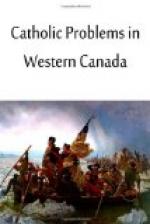The Period of Settlement
When a few years ago our shores were heavily invaded by the rising tide of an intense immigration from the British Isles and Continental Europe, the Church had to face conditions heretofore unknown. Without doubt, the most complex in its elements, the most serious in its consequences, was the Ruthenian issue. It was a case of providing for the spiritual wants of over a quarter of a million souls. The dearth of priests, the difference of rite, the difficulty of language, and the great number of Ruthenians, created for the Church an almost insurmountable barrier which nothing short of a miracle could otherthrow [Transcriber’s note: overthrow?]. This sudden and large influx of Catholics belonging to the Greek rite, into a Country where the Latin Church alone prevailed, constitutes a fact that has never been seen before in the history of the Church. Thousands and thousands of these Greek Catholics were scattered through the prairies; roaming flocks without shepherds, a prey to ravening wolves. Heresy, schism, atheism, socialism and anarchy openly joined hands to rob these poor people of the only treasure they had brought with them from the old-land,—their Catholic Faith. Presbyterian ministers were seen to celebrate among them “bogus masses”; schismatic emissaries tried to bribe them with “Moscovite money”; fake bishops were imposing sacrilegious hands on out-laws and perverts; traitors from among their ranks, like Judas, bartered away their faith for a few pieces of silver; a subsidized press,—“The Canadian Farmer” and “The Ranok”—was ever at work, playing on their patriotism and exploiting their racial feelings, to cover with ridicule their faith and pious traditions. The public school became in the hands of the enemy the most powerful weapon. Government itself, through its various officials, often went out of its way to thwart the efforts of our missionaries.




